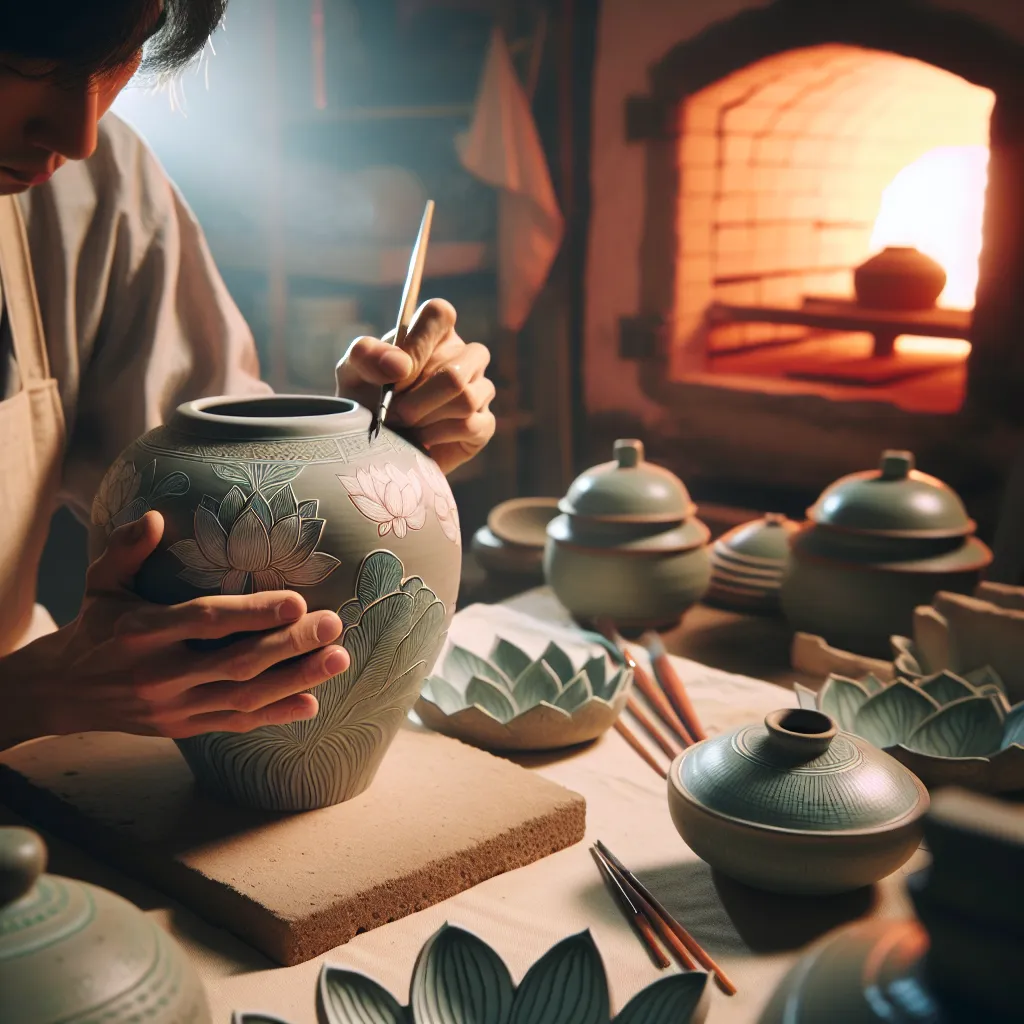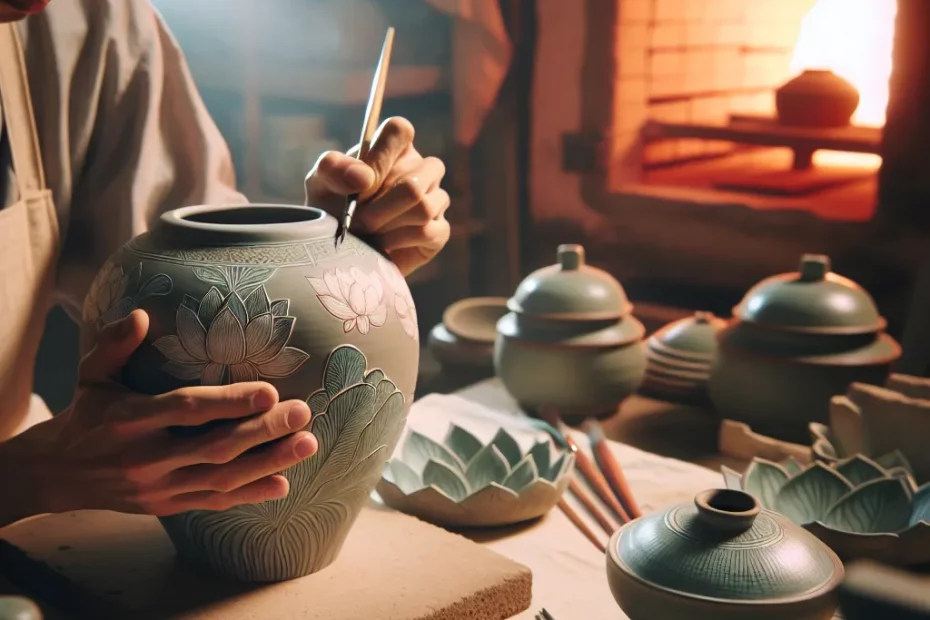Korean celadon, known for its exquisite beauty and intricate designs, stands as a testament to Korea’s rich ceramic heritage. The artistry and craftsmanship involved in creating celadon pieces reflect the deep cultural significance attached to them. Exploring the history of Korean celadon unveils a story of innovation and artistic excellence that dates back centuries. Techniques and secrets passed down through generations contribute to the unique quality of each piece, showcasing the mastery of Korean artisans. Symbolism and meaning are intricately woven into the designs, adding layers of depth and significance to these works of art. The preservation and revival of Korean celadon art underscore the ongoing efforts to honor tradition while adapting to modern times. In essence, Korean celadon serves as a timeless bridge connecting the past with the present, embodying the essence of Korea’s ceramic legacy.

Exploring the History of Korean Celadon
In the realm of ceramic artistry, Korean celadon stands as a shining example of Korea’s rich cultural heritage and artistic prowess. Dating back to the Goryeo dynasty (918-1392), Korean celadon is renowned for its exquisite craftsmanship, intricate designs, and distinctive jade-green glaze. This unique art form flourished during the Goryeo period, reaching its peak in the 12th century when Korean potters perfected the technique of creating celadon ceramics.
The Origins of Korean Celadon
The history of Korean celadon traces back to the 9th century when Korean potters were inspired by Chinese celadon wares. However, they soon developed their own distinctive style characterized by a delicate green glaze and intricate inlaid designs. The Goryeo potters mastered the art of inlaying intricate patterns of flowers, birds, and other natural motifs using white slip, creating a stunning contrast against the jade-green background.
Popularity and Influence
Korean celadon quickly gained popularity not only in Korea but also in neighboring countries such as China and Japan. Its elegant beauty and fine craftsmanship captivated the hearts of art enthusiasts and collectors across East Asia, solidifying Korea’s reputation as a center of ceramic excellence.
Distinctive Features
One of the most remarkable features of Korean celadon is the use of iron oxide in the glaze, which gives the ceramics their distinctive green color. The firing process, which involves multiple firings in a reducing atmosphere, is crucial in achieving the desired color and texture of the celadon ware. This meticulous process requires precision and skill, reflecting the dedication of Korean potters to their craft.
Legacy and Preservation
Over the centuries, Korean celadon has evolved and adapted to changing artistic trends and technological advancements. Despite facing challenges such as wars and foreign invasions, Korean potters have preserved and revitalized the tradition of celadon making, ensuring its continued legacy in the modern era.
Celebration in the Modern Era
Today, Korean celadon continues to be celebrated for its timeless beauty and cultural significance. Museums and galleries around the world showcase exquisite pieces of Korean celadon, allowing audiences to appreciate the artistry and craftsmanship of this ancient tradition. As we delve into the history of Korean celadon, we are not just exploring a form of ceramic art but also unraveling the rich tapestry of Korea’s cultural heritage and artistic ingenuity.
In conclusion, Korean celadon stands as a testament to Korea’s enduring legacy in the world of ceramic art. Its exquisite beauty, intricate designs, and rich history continue to captivate audiences and inspire admiration for the craftsmanship of Korean potters throughout the ages.
Techniques and Secrets of Celadon Making
The Art of Glazing
Celadon glazes are known for their distinctive jade-green color, achieved through a meticulous combination of iron oxide and other minerals. The glazing technique involves multiple layers applied to the pottery before firing, each layer contributing to the final lustrous finish that defines celadon ware.
Firing in Reduction Kilns
Celadon pieces are traditionally fired in reduction kilns, where a controlled reduction atmosphere inhibits the flow of oxygen during firing. This unique environment not only enhances the color of the glaze but also creates the characteristic crackled patterns that are highly prized in celadon ceramics.
Intricate Carving and Inlay
Beyond the glazing and firing, celadon making often involves intricate carving and inlay techniques. Artisans meticulously carve intricate designs onto the surface of the pottery, revealing the contrasting clay beneath the glaze. Inlay, where different colored clays are applied to create patterns, adds another layer of complexity and beauty to celadon pieces.
Inspiration from Nature
The artistry of celadon is deeply rooted in nature, with many designs and motifs inspired by the natural world. From delicate lotus flowers to graceful cranes, celadon pieces often feature motifs that symbolize longevity, purity, and harmony with the environment. This connection to nature infuses celadon with a sense of tranquility and timelessness.
Guarded Secrets and Traditions
Throughout history, the techniques of celadon making were closely guarded secrets, passed down within families or from master to apprentice. These traditions not only preserved the artistry of celadon but also ensured the continuity of Korea’s ceramic heritage. Even today, modern artisans honor these traditions while incorporating contemporary elements to keep celadon relevant in the modern world.
A Legacy of Beauty and Elegance
In conclusion, the techniques and secrets of celadon making are a testament to Korea’s rich ceramic heritage. From the meticulous glazing process to the intricate carving and inlay techniques, celadon embodies a legacy of beauty, elegance, and cultural significance. Each celadon piece tells a story of craftsmanship and artistry, inviting us to appreciate the timeless allure of this ancient art form.
Let the jade-green beauty of celadon ceramics transport you to a world where tradition and innovation converge in perfect harmony.
Symbolism and Meaning in Korean Celadon
Korean celadon, known for its exquisite beauty and intricate designs, holds a deep symbolic meaning that reflects Korea’s rich ceramic heritage. The artistry of Korean celadon goes beyond mere aesthetics; each piece tells a story and conveys profound cultural significance.
The Color of Harmony
The delicate green hue of Korean celadon, achieved through a unique glazing technique, symbolizes harmony with nature. This color, reminiscent of lush forests and tranquil landscapes, represents the deep connection between the artisan and the natural world. It evokes a sense of balance and tranquility, inviting viewers to contemplate the beauty of the earth.
Symbols in Patterns
In addition to its color, the intricate patterns and motifs found on Korean celadon pieces carry symbolic meanings. The lotus flower, a common motif in Korean celadon, symbolizes purity, enlightenment, and rebirth. Its presence on a celadon piece signifies spiritual growth and the journey towards enlightenment.
Another common motif found in Korean celadon is the crane, which symbolizes longevity, good fortune, and loyalty. The graceful depiction of cranes in flight on celadon vessels conveys a sense of elegance and grace, while also invoking wishes for a long and prosperous life.
Geometric Harmony
The use of geometric patterns, such as the iconic “sanggam” design, reflects the meticulous craftsmanship and attention to detail of Korean celadon artisans. These intricate patterns not only showcase the technical skill of the artisans but also hold symbolic meanings related to unity, harmony, and balance.
Symbolism in Shapes
Furthermore, the shapes of Korean celadon vessels themselves carry symbolic significance. The graceful curves and elegant forms of celadon bowls and vases are reminiscent of traditional Korean architecture and embody the concept of harmony between form and function. Each piece is carefully crafted to not only serve a practical purpose but also to evoke a sense of beauty and harmony in everyday life.
In conclusion, Korean celadon is not simply a form of ceramic art; it is a reflection of Korea’s cultural heritage, with each piece carrying deep symbolic meanings that connect the past with the present. Through its intricate designs, symbolic motifs, and harmonious forms, Korean celadon continues to captivate viewers and serve as a testament to the artistry and craftsmanship of Korean artisans throughout history.
Preservation and Revival of Korean Celadon Art
In the realm of ceramic art, Korean celadon stands out as a true masterpiece, reflecting the rich heritage and artistic excellence of Korea. The delicate green hues, intricate designs, and flawless craftsmanship of Korean celadon have captivated art enthusiasts for centuries. However, the preservation and revival of this ancient art form have been a challenging yet rewarding endeavor.
The History of Korean Celadon
The history of Korean celadon dates back to the Goryeo dynasty (918-1392), where it flourished as a symbol of elegance and sophistication. During this period, Korean potters perfected the art of creating celadon ceramics, known for their unique jade-like glaze and intricate inlaid designs. These pieces were highly prized not only in Korea but also in neighboring countries, showcasing the exceptional skill and creativity of Korean artisans.
Challenges and Revival Efforts
Despite its historical significance, Korean celadon faced a decline in popularity during the Joseon dynasty (1392-1910) as white porcelain became the preferred choice of the royal court. The art of celadon making was nearly lost during this time, with only a few master potters carrying on the tradition in remote villages.
In recent years, there has been a renewed interest in reviving Korean celadon art, thanks to the efforts of dedicated artisans and cultural organizations. Through meticulous research, experimentation, and collaboration, modern potters have been able to recreate the traditional techniques and glazes used in ancient celadon pieces.
Preserving the Tradition
One of the key challenges in preserving Korean celadon art lies in sourcing the materials needed to create the distinctive celadon glaze. The unique combination of iron oxide and other minerals required for the celadon glaze poses a technical challenge for contemporary potters. However, through innovative methods and scientific analysis, artisans have been able to replicate the coveted celadon glaze, ensuring the authenticity of their creations.
Role of Cultural Institutions
Furthermore, cultural institutions and government initiatives have played a crucial role in promoting and preserving Korean celadon art. Museums and galleries across Korea showcase exquisite celadon pieces, educating the public about the cultural significance and artistic value of these treasures. Additionally, cultural festivals and workshops provide a platform for artisans to demonstrate their craft and pass on their knowledge to future generations.
The revival of Korean celadon art not only preserves a valuable cultural heritage but also celebrates the enduring legacy of Korean craftsmanship. By honoring the traditions of the past and embracing innovation, Korean artisans continue to create exquisite celadon pieces that captivate the world with their beauty and artistry. The revival of Korean celadon art is a testament to the resilience and creativity of the Korean people, ensuring that this ancient art form will continue to inspire and enchant for generations to come. 🌿🏺✨
Korean celadon ceramics stand as a testament to Korea’s rich artistic heritage, showcasing exquisite craftsmanship and intricate designs that have been passed down through generations. The history of Korean celadon unveils a story of innovation and cultural exchange, reflecting the country’s deep-rooted connection to the art of pottery. The techniques and secrets behind celadon making highlight the meticulous attention to detail and the skilled hands of the artisans who bring these masterpieces to life. Each piece of Korean celadon carries profound symbolism and meaning, often drawing inspiration from nature and traditional Korean beliefs. The ongoing efforts to preserve and revive Korean celadon art demonstrate a commitment to honoring the past while embracing the future of ceramic artistry. In essence, Korean celadon serves as a timeless reminder of Korea’s enduring legacy in the world of ceramics.
